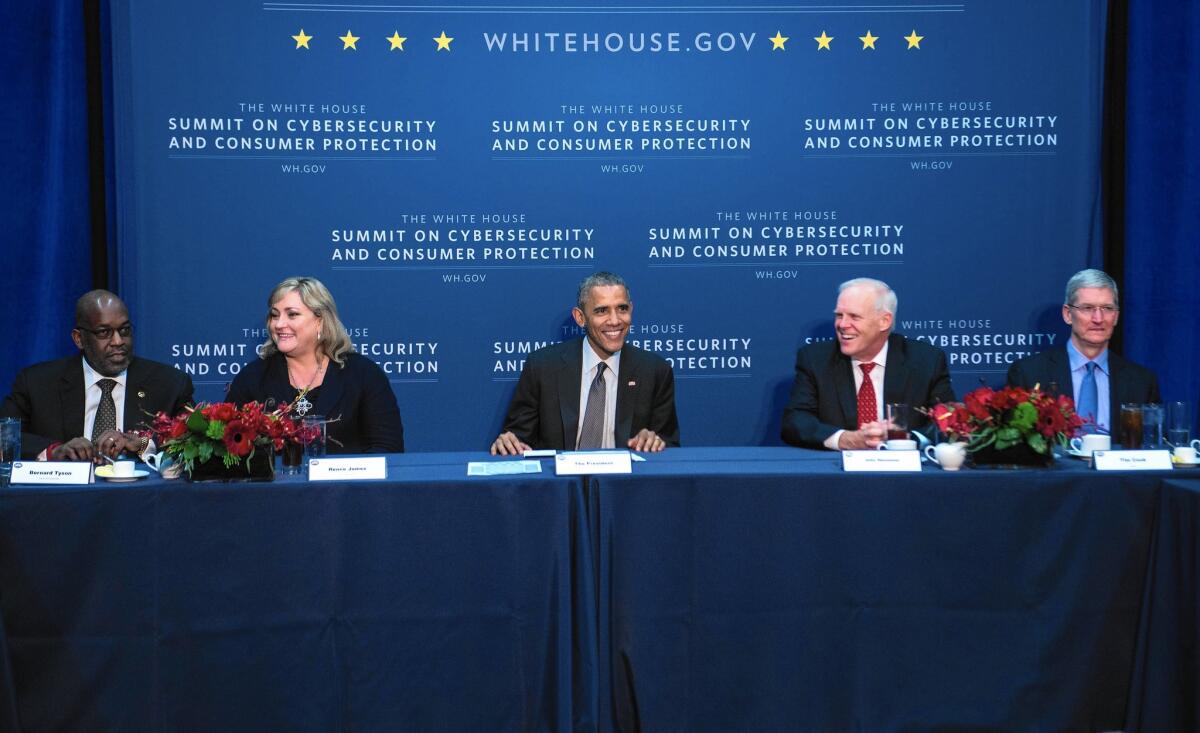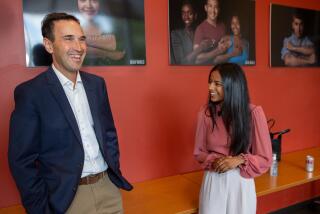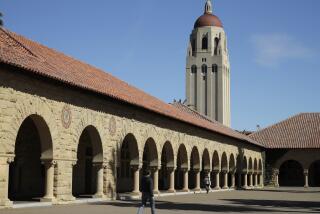Departure of Stanford’s president ends a transformational era

Stanford University President John L. Hennessy, second from right, takes part in a roundtable with President Obama and business leaders in February.
In his 15 years at the helm of Stanford, President John L. Hennessy has more than doubled the university’s endowment, seen its undergraduate program displace Harvard as the most selective school in the nation and fostered a symbiotic relationship between campus brains and Silicon Valley money that created tech darlings such as Snapchat and Instagram.
But asked to recall his proudest moment Friday, the day after he announced plans to step down, Hennessy did not cite his impressive fundraising or the professors and students who have become Internet royalty. Instead, he recalled the decision seven years ago to make Stanford University affordable for poor and middle-class students. The school waived tuition for families with incomes less than $100,000 and gave free room and board to those earning less than $60,000.
“We believed it was the right message: If you can get into Stanford, we will make it possible for you to attend, no matter your family circumstances,” Hennessy said. (The school subsequently raised the cutoff levels to $125,000 and $65,000.) “I received more positive alumni letters about this decision than any others.”
Several other high-profile schools, including Harvard and Yale, offer similar programs.
As word spread that Hennessy, 62, was leaving next year, Stanford colleagues, alumni and peers in academia lauded him as one of the most effective and transformational higher education leaders in a generation. They described his appointment to the post in 2000 as the right person (an accomplished computer scientist who had founded his own company) at the right time (the maturing of the start-up economy) in the right place (Palo Alto).
“He brought that background to Stanford at a point where technology exponentially changed the world we live in,” said Terry W. Hartle, a senior vice president at the American Council on Education, which represents the presidents of U.S. higher education institutions. “The basic question of any university president is, did you leave it a better place and by any reasonable measure, the answer in John’s case is absolutely.”
Unlike many university administrators, whose sway wanes beyond the school grounds, Hennessy held enormous influence outside the campus gates. As a computer science professor and later the dean of the engineering school, Hennessy worked closely with many students who went on to become industry giants, including Sergey Brin and Larry Page of Google, and Yahoo co-founder Jerry Yang.
He encouraged tech executives and venture capitalists, many of whom were alumni, to spend time on campus, teaching courses, acting as mentors and listening to funding pitches from students. The power to connect brilliant young students with established industry figures hungry for the next new thing made him an important player.
A 2012 New Yorker article about the school’s relationship with Silicon Valley quoted renowned venture capitalist Marc Andreessen: “John Hennessy is the godfather of Silicon Valley.” The article noted that when President Obama visited the area in 2011 to meet with leaders such as Mark Zuckerberg of Facebook and former Apple chief Steve Jobs, Hennessy was the only non-industry figure invited.
Yang, who heads the venture fund AME Cloud Ventures, called Hennessy “a huge influencer” in Silicon Valley.
“When tech leaders get together with John, they listen to him,” Yang, a major donor and university trustee, told the Times on Friday.
Yang, who formerly served on Cisco’s board with Hennessy, said the president’s long-term business experience, coupled with his years of teaching, allows Hennessy to give crucial advice to young entrepreneurs about how to “grow companies from zero to thousands of employees.”
Hennessy began teaching electrical engineering at Stanford in 1977 but took a sabbatical in 1984 to co-form MIPS Computer Systems, which was sold eight years later for $333 million.
After founding MIPS, Hennessy returned to Stanford and taught before becoming dean of the School of Engineering, then rose through the ranks before becoming president.
During his time at Stanford, Hennessy sat on several boards, including Cisco’s and Google’s — which drew some criticism from faculty who said the positions would give corporations undue influence on campus — and invested in venture-capital firms. A 2007 Wall Street Journal article reported that Hennessy earned $43 million during the previous five years.
“In my view, presidents should avoid even the appearance of conflict of interest,” said Debra Satz, the senior associate dean for humanities and arts.
She said that while she still objected to his sitting on company boards, Hennessy had won her over with the respect he showed faculty members across departments. Satz recalled him coming to her office before he assumed the presidency to discuss, among other things, her experiences as a female professor.
“Nobody had ever asked to see me in that way,” Satz said. “It was emblematic of his openness.”
As stories of undergrads launching start-ups in dorms became more and more familiar, the already well-respected Stanford became increasingly alluring to elite high school students. In 2000, the year Hennessy was elevated from provost to president, about 18,000 students sent in applications. Last year, more than 40,000 sought admission.
The admission rate last year was about 5%, making entrance to Stanford slightly more difficult than traditional standard bearers in the Ivy League.
In the fiscal year of 2001, Hennessy’s first as president, the school received nearly $470 million in gifts. Last year, the school received about $930 million.
Nicole Gracie, a Long Beach educational consultant who counsels parents and students on the admissions process, said Stanford’s popularity among her clients had increased in recent years, in part because of the school’s reputation for turning out graduates with many well-paying job offers from tech firms.
“Parents want to secure their children’s future,” she said. “There is this feeling that there are amazing professors and, afterward, amazing jobs at amazing companies.”
Stanford officials said they planned to conduct an international search for his replacement.
Times staff writer Andrew Khouri contributed to this report.
More to Read
Start your day right
Sign up for Essential California for news, features and recommendations from the L.A. Times and beyond in your inbox six days a week.
You may occasionally receive promotional content from the Los Angeles Times.









